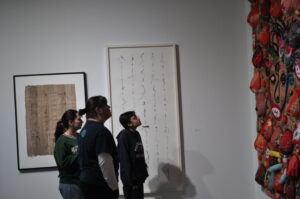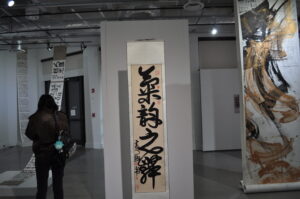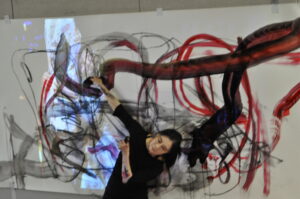On Feb. 5, the TCNJ Art Gallery celebrated the exhibition opening of “Dancing with the Qi: TransMediating Chinese Calligraphy.” The exhibition showcases Chinese calligraphy embodying the flow of Qi, the vital energy of artistic creativity.
The exhibition, curated by Jia-Yan Mi, associate professor of Chinese and English at TCNJ and Jerry Kaba, independent artist and curator, featured six different artists’ work: Huang Xiang, Cui Fei, Sin-yang Ho, Xin Song, Yin Mei and Zhen Guo.
Throughout both the exhibition and the opening performances, the artists and their work demonstrate the long lasting power of Chinese calligraphy in the ever-evolving landscape of artistic expression.
During the opening event, a panel and reception were held in the AIMM building. The panel featured all six of the artists, as they described their own personal creative processes and answered questions.
Huang Xiang, Chinese poet and calligrapher, invited the audience to learn about his creative process step by step.

“The first step of my creative process is to go beyond the thinking of time and space, transcend it,” he said. For Huang, art is about more than form; it is about channeling energy that defies the limits of the material world.
Traditionally, Chinese calligraphy has to be on rice paper. In this exhibit, the artists work in a variety of mediums, including ceramics, cut paper, photographic processes, found materials and ink on paper. Jia-Yan Mi, the curator, described the exhibit’s purpose as to “go beyond the traditional” since it is a new age of art.
Throughout the panel, the artists also discussed the new age of artificial intelligence and its impact on human-made art.
“What remains of art when AI can produce almost anything?” Sin-Yang Ho said. “It’s not about the product; it’s about the experience and the connection between the artist and the medium.”
Yin Mei, a performance artist who intertwines dance and calligraphy, emphasized the connection between movement and creative expression.
“If there is room for humans to exist, then humans will express,” she said.
In addition to the visual artwork, the opening night featured a live performance that blended traditional calligraphy with modern movement and music. Yin Mei performed an expressive dance, responding to each brushstroke in real time. The interplay between ink and movement captivated the audience, highlighting the deep connection between written and physical expression.
The exhibit not only strives to showcase artistic skill but also to provoke thought on the evolution of artistic mediums. As the world of art continues to change, this exhibition serves as a bridge between past, present and future. The discussions at the panel further reinforced this theme, as the artists engaged in conversations about the intersection of Chinese culture, technology, and artistic expression.
With its combination of traditional artistic techniques and modern interpretations, the art exhibit is a must-see for both art lovers and those interested in the cultural significance of Chinese calligraphy and art. The exhibition will be open to the public for free through March 13 in the TCNJ Art Gallery.
– Allison Uhlendorf ’26


